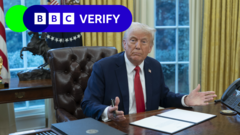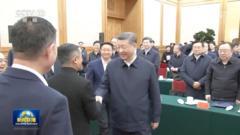As Trump's trade policies unfold, immediate tariffs on China have ignited reciprocal measures from Beijing. However, the delay in tariffs against Canada and Mexico leaves uncertainty about future trade relations and investments across North America.**
The Implications of Trump's Trade Intentions: A Cautious Outlook**

The Implications of Trump's Trade Intentions: A Cautious Outlook**
Analyzing the immediate effects of Trump's tariffs on China and North America while considering potential long-term economic consequences.**
The opening shots in Donald Trump's renewed trade policies have drawn immediate attention, particularly with the imposition of a 10% tariff on all goods imported from China, while tariffs against Canada and Mexico are currently on hold for 30 days. As a result, the global economy appears to be on the brink of uncharted territory, presenting both opportunities and challenges.
Following Trump's announcement, China swiftly signaled its intent to retaliate, proposing tariffs on U.S. imports such as energy and automotive products. This reciprocal action marks a potential shift towards a trade war, as the concept of "tit-for-tat" policies comes into play. Economic historians have long cautioned that such conflicts tend to escalate rapidly, often spiraling out of control.
Trump's justification for tariffs has ranged from increasing government revenue to stimulating domestic manufacturing and correcting trade imbalances. The world's attention is now focused on whether these tariffs will achieve their intended objectives or whether they may lead to further tensions. For instance, Trump's inclination towards tariffs has historically been an influential tool to navigate diplomatic negotiations, as demonstrated with Colombia's recent compliance regarding deported nationals.
However, the effectiveness of this strategy remains debatable, especially given potential non-compliance from other countries. A detrimental cycle could ensue if foreign nations choose not to yield to Trump's demands, possibly leading to escalated tariffs and counter-retaliations. This precarious situation creates a climate of mistrust and considerably heightens the stakes for all involved.
Economists express concern regarding the long-term ramifications of this tariff diplomacy. The U.S. automotive industry, characterized by a deeply interconnected supply chain with Mexico and Canada, faces threats from potential tariffs of 25%. While these punitive measures are currently on pause, uncertainty abounds, compelling manufacturers to reconsider future investments in cross-border operations. Critics argue that such hesitance could ultimately undermine productivity and negatively affect wage growth for workers across all three nations.
Globally, these uncertain economic conditions raise questions about investment patterns and manufacturing locations. In the past, U.S. tariffs against China prompted multinationals to pivot operations to countries like Vietnam and Malaysia, seeking to evade additional taxes. Yet, the prospect of Trump expanding tariffs to these countries creates further unpredictability that can stymie investment decisions.
In conclusion, as Trump's tariff strategies evolve, they appear to inject significant uncertainty into the global economy. Whether these tactics will prove beneficial for the U.S. economy or lead to broader repercussions remains an open question that demands close monitoring.





















